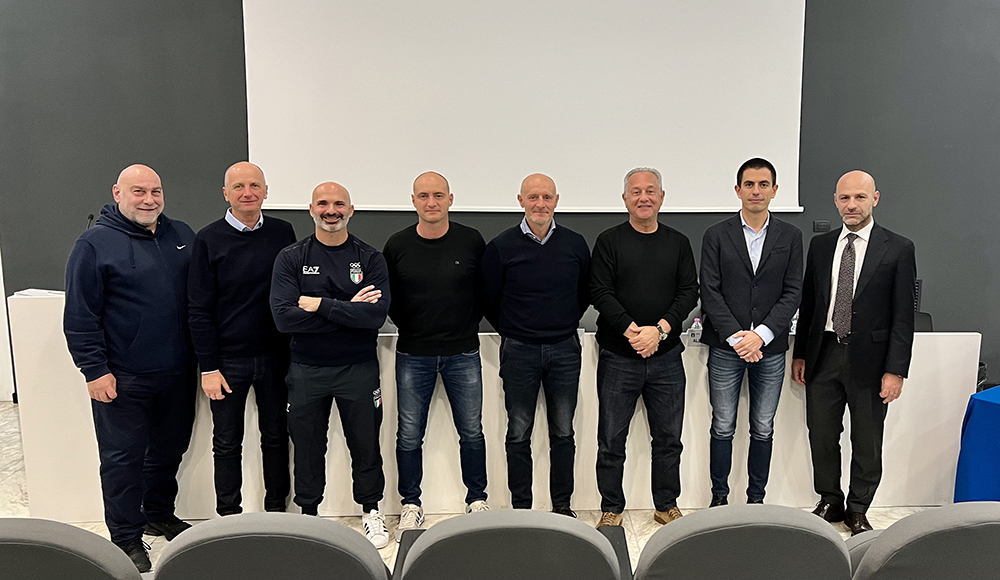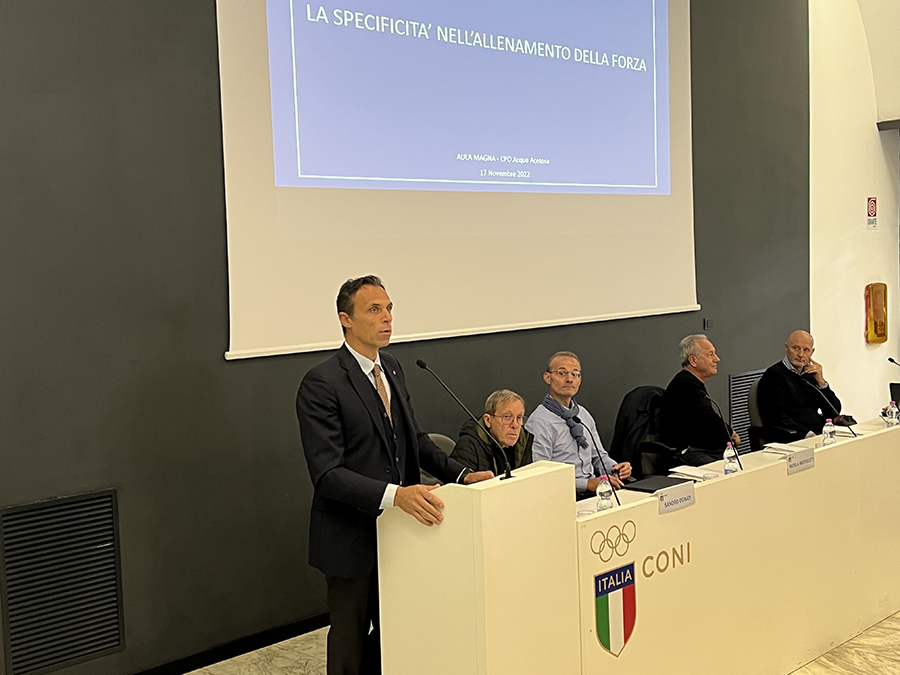Strength training seminar at CPO Acqua Acetosa, Mornati: “A useful meeting for exchanging ideas and growth”

The Aula Magna of the “Giulio Onesti” Olympic Preparation Centre at the Acqua Acetosa in Rome hosted “Specificity in Strength Training”, a new seminar organised by the CONI Institute of Sports Medicine and Science, aimed at technical directors and federal technical staff.
CONI Secretary General Carlo Mornati opened the meeting: “In this meeting we will deal with the topic of strength training contextualised in specific areas, from water to land to combat sports. We don’t want to impose anything from above: these seminars serve to exchange ideas, because it is always good to share in order to create a stimulus and return home with some ideas upon which to reflect and analyse. After all, strength is a common element in any sport, even if it is applied in different ways. It is interesting to see how it can be used to the best effect. We also have a novelty: we have succeeded in setting out a new Olympic training project that we had been working on for a year. We wanted to activate a process for selecting and training coaches that would have IOC compliance. We have succeeded: we are going to have this Olympic training programme and we are going to organise it on a platform so that everyone can participate and be involved. I believe we will be operational from January with something brand new, another moment of reflection to grow and improve”.

The Head of CONI’s Institute of Medicine and Sport Science Giampiero Pastore then introduced the speakers, first of all launching a speech by Sandro Donati, Training Methodology Coordinator, CONI Institute of Sport Science: “To frame the term “strength” we must start from the concept of sports training. Any exercise implies functional aspects of strength with the participation of coordination skills. An exercise can never be an end in itself, but must be functional to the objective: everything is linked to a unified vision. It is essential to learn the movements, exercises and inputs given by a coach which, if correctly understood, become the so-called 'muscle memory'”. Next Nicola Maffiuletti, Director of the Neuromuscular Research Laboratory Clinic Schulthess in Zurich, addressed the topic of specificity or variety in strength training: “In reality, we are moving more towards specificity, with a focus on biomechanical variables. The classical approach has limitations, there is a need for an alternative approach that gives more space to the neural and cognitive part and seeks “neuro-mechanical” specificity. The aim is to improve activation and motivation, maximising effectiveness and adherence, and varying the neural and cognitive stimuli”.
Julio Velasco, currently Technical Director of the FIPAV Youth Sector, also gave a valuable speech on the problems facing volleyball players: “Thinking about our sport, the specificities are primarily the type of strength and neuromuscular characteristics of the players. The problem arises when training slow players. One hypothesis could be the search for maximum strength to activate recruitment and immediately move on to synchronisation with power at high and low loads.” Closing the morning session was Marco Lancissi, Head of Athletic Preparation of the FIN National Swimming Teams: “The variables to be taken into account when swimming fast are propulsive efficiency, mechanical power, i.e. the power “discharged” into the water, and finally drag and everything concerning the power of the water. Reducing drag, the speed of swimming increases. The aim is to increase energy power, mechanical power and propulsive efficiency and reduce drag by trying to find the most hydrodynamic position possible and offering the least resistance as the body moves forward. Of great importance is the balance between mobility and strength, which is indispensable to improve the technical economy of the swim and also its efficiency”.
Gennaro Boccia, Researcher and Lecturer in Training Theory at the University of Turin, FIDAL Research Technician and FIP National Trainer, spoke about the role of movement control in strength training, while Pietro Roca, Head Coach of the FIPE Olympic Weightlifting National Team, emphasised that one should not “make an analysis to develop an athlete’s strength to the maximum, but try to allow them to exercise their strength without dispersing it. We are interested in enabling the athlete not to accumulate an unnecessary level of fatigue. We have to understand their weaknesses and try to bring out their strengths”.
“Our players,” observed Paolo Barbero, Physical Trainer at Torino Calcio, "must be developed as athletes and their genetic background must be maximised correctly and efficiently. Talent must be supported by strength training, one of the prerequisites for winning performances. Our guidelines are primarily: train movements, keep analytical exercises to a minimum and alternate vertical-horizontal and lateral force vector exercises. Our primary goal is to improve the player’s athleticism". Alberto Di Mario, Physical Trainer, Consultant of the CONI Institute of Sport Science and Lecturer at the University of Rome “Foro Italico” and Tor Vergata, focused on combat sports, where “the evaluations of the technical action are very complex, extremely fine and limited to the circumstances of the discipline. We have to identify the characteristics of athletes and adopt those methodologies aimed at their improvement. In the past there was a very simple calendar while today there are about 15 to 20 competitions a year in which maximum performance is required. The objective is always to lead the athlete to improvement also by trying to limit certain negative factors that may arise in the work to achieve explosive or rapid strength”. The final speech was by Carlo Varalda, Physical Trainer of the FISG National Short Track Team: “A trainer must first and foremost not do any harm to the athletes. It is essential to optimise and personalise as much as possible: that certainly means working harder, but to do this task you must want what is good for the athlete. Studies have shown us that working with velocity-based training allows you to obtain results with lower work volumes. I believe it must be used with the aim of producing strength, accompanied by its correct modulation and optimisation.


